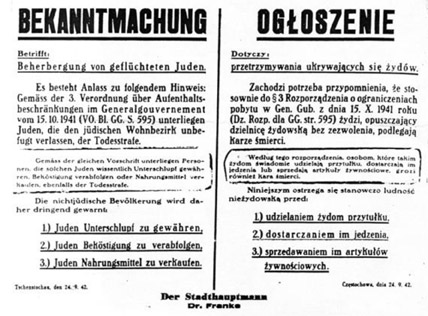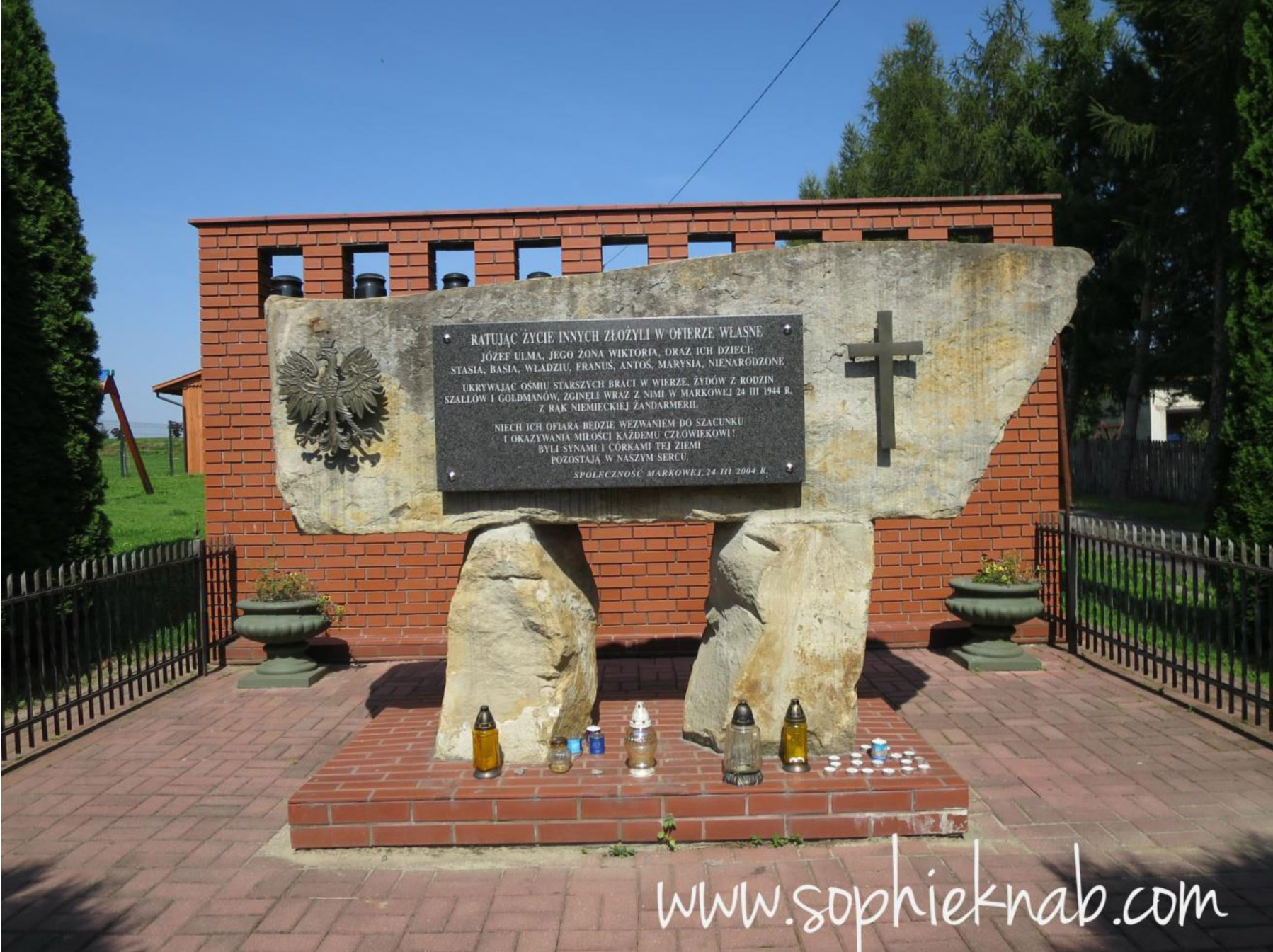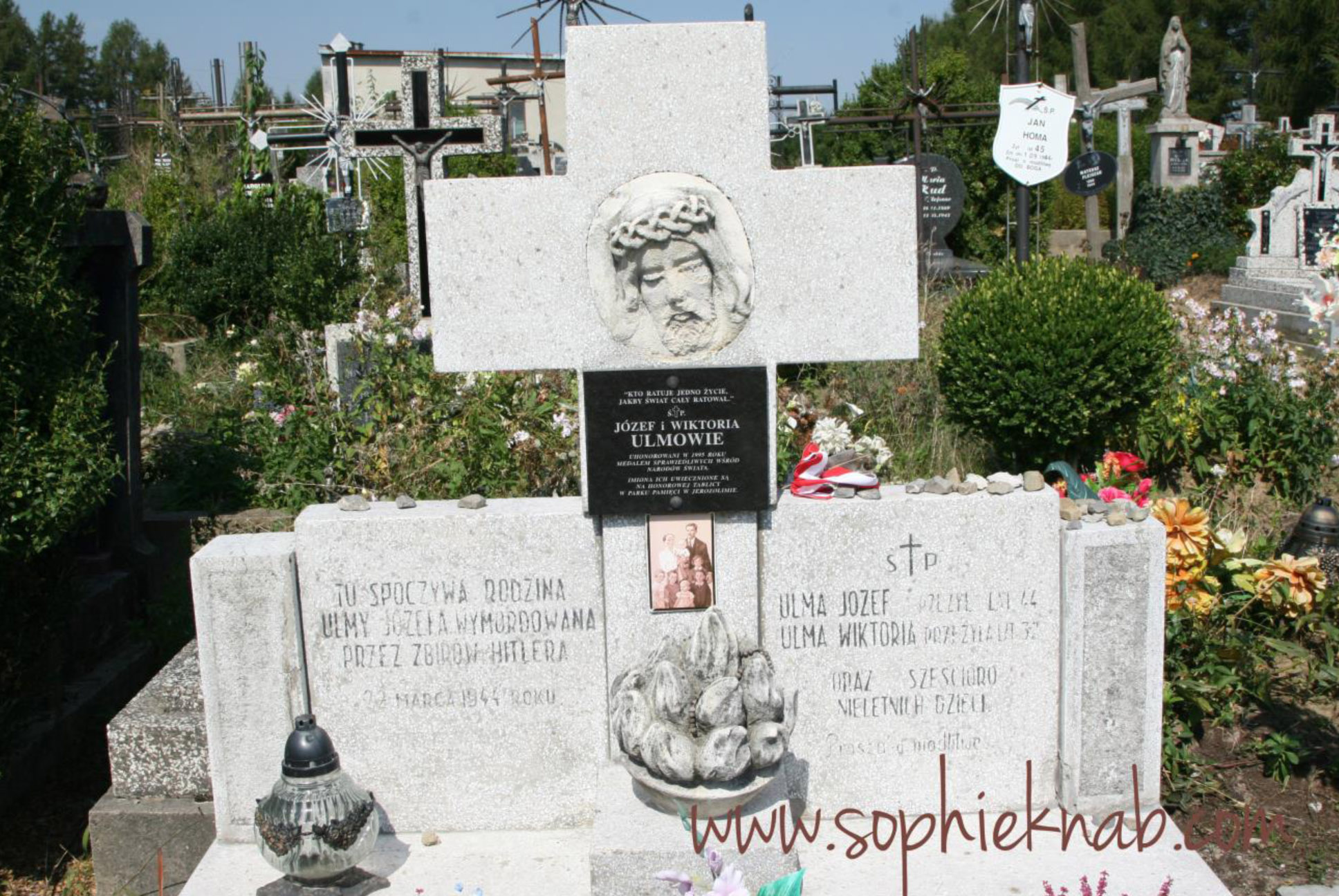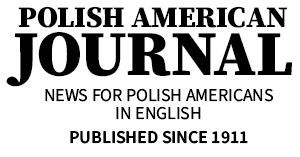The Ulmas of Markowa
by Sophie Hodorowicz Knab
Polish American Journal (2012)
The invasion of Poland by Germany on September 1, 1939 brought on one of the ugliest chapters in human history filled with the death and destruction of human lives to an unprecedented degree. The toll on the civilian population consisted of mass shootings, death in concentration camps, starvation in ghettos, street roundups, separation of families, sometimes forever, privations and hunger in forced labor camps, Polish children and infants were torn from their mother's arms to be raised as Germans, entire villages were burnt to the ground. Yet, amidst the savage brutality, the seeming absence of any kind of humanity, it was also a time filled with unparalleled acts of courage and bravery. There was the Polish underground (AK-Armia Krajowa), the many unsung heroes and heroines who fought valiantly with limited weapons to resist the powerful Nazis. There were those who gave up their lives, like Maximillian Kolbe, so that others could live. Then there were those everyday people, Poles going quietly about their lives, risking that very life and that of their families to feed, to hide, to save their fellow man. There was Irena Sendler, a thirty three year old who smuggled Jewish infants and children out of the Warsaw ghetto placing her life in danger each day; Irena Gut Opdyke, who hid Jews in the basement of a villa where she worked as a housemaid to a German officer; Jan Karski who acted as a courier between occupied Poland and the Allies reporting the mass murders in concentration camps in an effort to stop the Holocaust. Fortunately, these individuals lived to tell their story.
This story is different. It is the story of the Ulmas of Markowa. They did not live to tell their story, but eyewitnesses of the event have stepped forward to recount the event and allowing the world to know about them.
When the Germans occupied their portion of Poland, the country was divided into two regions. The Germans annexed approximately 25% of western Poland that bordered directly with Germany into the Third Reich and called the region the Incorporated Eastern Territories. The remaining portions of central and southern Poland, extending to the rivers Bug and San to the borders of what was now Russian occupied Poland, was organized into a region called the Government General and was placed under the leadership of a Nazi official named Hans Frank. In both regions Jews and Poles were placed beyond the protection of the law and any judicial processes. No matter what the Germans did to either the Jews or the Poles, there was no one to whom they could turn to for help.
Hatred for the Jews had been sown in Germany before the start of the war and now, in complete control of millions of Polish Jews who were beyond any protection of the law, the Jews were robbed of their property, forced out of the incorporated eastern territories to make it a "pure" country filled with only Aryans (blonde, blue-eyed individuals of German stock) and sent to the Government General where they were segregated into restricted areas called ghettos. The appointed administrator of the region Hans Frank and his henchmen began a program of rationing food on a severe level .
Eventually in October of 1941, at a government conference, Hans Frank proposed even harsher rations for the starving inhabitants of the Warsaw ghetto :
1050 grams Bread per week
300 grams Sugar monthly
1 egg monthly
100 grams Marmalade monthly
50 grams Fat monthly
1 dozen Potatoes per year
Fish when available
Vegetables when available
(Frank Diaries. Government Conference pp. 13 and 14 of October 14, 15, 16, 1941)
When converted from the metric system, this amounted to 37 ounces of bread per week, 10 ounces of sugar a month, 3.5 ounces of marmalade, 1.8 ounces of fat and a dozen potatoes a year. Even Frank realized "these provisions are too small to sustain life" and that the Jews would die when he casually stated "the death rate will doubtlessly increase this winter. But after all, this war is a matter of a fight against Jewry in its entirety." (Frank Diaries. Government Conference pp. 13 and 14 of October 14, 15, 16, 1941. National Archives Document 2233-PS)
Operating simultaneously with the food rationing were food quotas imposed on Polish farmers. At the beginning of the occupation, the Germans began a strict accounting and record of the holdings of each Polish farmer. A special commission was established by the Germans to examine and register all workable land under cultivation, to inventory all animals and trees in orchards, and to examine private and public forests. This took place every year regulating every aspect of farming and agriculture — grain for bread, fodder for animals, wood from the forest, plants that produced oil, vegetables, fruit, eggs, milk, wool, straw and hay, horses, pigs, and cows. Based on these findings, every farm was assigned a yearly quota of grain, potatoes, meat, milk and fruit which had to be delivered at designated points in the district established by the Germans. Polish products were being carried off by the Germans to meet the needs of the Reich and the German armies. Failure to produce the required quotas imposed on a farmer resulted in heavy fines and even imprisonment. As a result, the Polish people were also suffering from hunger and malnutrition, with reports indicating "that the majority of Poles eat only 600 calories whereas the normal requirement for a human being is 2,200 calories." (PS-P-2233 Nazi Conspiracy and Aggression.)
That same autumn the Nazis instituted Operation Reinhard, a plan to systematically murder the Jews of the General Government. As part of their plan, they established three killing centers in Poland — Belzec, Sobibor and Treblinka. Their sole purpose was the mass murder of Jews. On October 15, 1941 Hans Frank, issued an edict whereby Jews could not leave the ghetto under penalty of death. In addition, anyone giving or selling them food would also be killed.
Posters with this decree began to appear in the cities of the General Government including Warsaw, Częstochowa, Kraków and eventually to smaller towns and villages.
On December 16, 1941 Dr. Hans Frank wrote in his diary:
"Severe measures must and will be adopted against Jews leaving the ghettos...every Jew found outside the ghetto is to be executed, must be carried out without fail. (Nazi Conspiracy and Aggression Document PS-Q-2233)
In southern Poland, one of the killing centers called Belzec was ready in the late winter of 1942 and began operations in March of 1942. Trains began shipping Jews to the killing centers for extermination. By late October 1942, more than two million Polish Jews were already dead, shot in what had been eastern Poland or gassed at one of the extermination centers. In 1943 and 1944, hundreds of thousands more Jews were being gassed at Auschwitz or shot in the East.
This was the climate in the General Government at the time that the story of the Ulmas unfolds in 1942.
The Ulma family lived in a fairly large town called Markowa situated outside of Łancut in southeastern Poland. In the fall of 1942, the Ulmas began to hide eight Jews - the Szall family, consisting of a father and his 4 sons, and two women by the name of Goldman and the daughter of one of the women.
Wiktoria and Józef Ulma
The Ulma family consisted of Józef, 42 years old, his wife Wiktoria, 30 years old and their 6 children: Stanisława, Barbara, Władysław, Franciszek, Antoni, and Maria. Józef had attended agricultural school and was an avid nurseryman but had a tremendous passion for photography which has provided a rich archive of family and community photos. The connection between the Ulmas and the Jewish families - what led the Szalls and the Goldmans to seek assistance from the Ulmas and what led the Ulmas to agree to this tremendously risky undertaking- is unknown. That it was a very real threat to their lives must have been clear to all parties involved. Unlike large cities such as Warsaw, where such secret organizations as Żegota operated clandestinely and purposefully to save the Jews, the decision to help another Jew in a small town or village had to be a personal, individual one. The risks involved with hiding a Jew were greater here: villagers generally knew everything there was to know about each other and they couldn't get "lost" in the hubbub of a bustling metropolis. The appearance of a long-lost "aunt" or "cousin," even if there were similar facial features, raised questions that could trip someone up. Buying or preparing more food at a time when food was scarce even in the countryside caused serious questioning. Hiding someone in your attic was possible but the smallest misstep, a moment of carelessness on either the part of those concealing or those in hiding yielded catastrophic results.
It is known that Józef had a reputation for being kind to the Jews. Perhaps living on the edge of town also factored into his decision. It is also known that Józef and the Jews worked together at tanning hides and that Józef sold these hides for money. Having committed to hiding an additional eight people, Józef had 16 people to feed during a time of hunger and terror. Together, the Ulmas, the Szalls, and the Goldmans managed to be safe until March of 1944.
There are suppositions and theories about what might have happened and who alerted the Germans to the presence of Jews at the Ulma farm, but no one knows for sure. What is sure is that in the early morning hours of March 24, 1944, the German military police and some of their lackies reached the house of Józef Ulma. Polish eyewitnesses state that the Jews were shot first — in the back of the head. The Poles were made to bear witness to what happens “to those who hide Jews” as they shot Józef and his wife Wiktoria, who was nine months pregnant. The children were screaming. When the question came up about what to do with the children, they shot them as well. Their ages ranged from 8 years old to 1½. Within minutes, 17 lives were lost. The village wójt (mayor) was instructed to bury the victims with the help of the other witnesses. The event was never forgotten by the inhabitants of Markowa.
In postwar Poland, Poles who saved Jews were often the object of repressive measures by the communists and sometimes even by their neighbors. Subsequently, the subject was not discussed. It is only recently, under a free and independent Poland, that Polish historians have begun to compile lists and gather written statements and documents from people who up until now kept quiet about their experiences of attempts to help and save Jews during the war.
In November 1995, the heroism of Józef and Wiktoria Ulma was recognized by the Jewish community when the Ulmas were posthumously awarded the medal of Righteous Among Nations by Yad Vashem. In 2003, the process of beatification of the Ulma family was begun by the Catholic Church. In 2004, on the 60th anniversary of their death, the community of Markowa unveiled a monument in memory of the Ulma family.
In March of 2012, on the 68th anniversary of the shooting of the Szall, Goldman, and Ulma families, the money to build the Ulma Family Memorial Museum of Poles Rescuing Jews in Subcarpathia (Muzeum Polaków ratujących Zydów na Podkarpaciu im. Rodziny Ulmów w Markowa) was encumbered. It is appropriate that such a museum be built in Markowa. In spite of the very real threat to their lives, the Poles of Markowa helped at least 17 Jews survive the war. Slated to be opened in 2014, the new museum is to be filled with archival material, films, and photo's. Multi-media presentations will be in Polish, English and Hebrew. Those visiting the museum will not only be able to see how the Ulma's lived but also how they hid the Jews.
Let us recall the words on the Ulma monument: May their offering be a call to respect and love every human being.
Part II
In the fairly large town of Markowa, situated outside of Łancut in southeastern Poland, the Catholic cemetery lies on the side of a hill. It's impossible to miss. At the base of the hill is the church from where parishioners /members of the congregation have been carried over the threshold and up to their final resting place somewhere along the hillside. There are many family plots, many metal crosses, some plain, some elaborately crafted by a master blacksmith. There are flat headstones with photographs of the deceased and many, many inscriptions asking for prayers for their soul. We don't know anyone in this cemetery. We don't have a family member or a friend buried here. We have come to pray and to give honor to a family that died 70 years ago at the hands of Nazis. The tragic story the Ulma family of Markowa bears telling and retelling.
Poland during World War II was a country full of tremendous suffering, death and destruction. It was a country occupied by the Nazi's who did everything they could to destroy a nation and its people. For the people living through those terrible years it was a time of trials and tests, of difficult choices and moral dilemmas. The Jewish people were persecuted, hunted down, sent to concentration camps and murdered by the millions. Anyone who made attempts to assist or harbored them were put to death. Among those who assisted Jews was the Ulma family.
At the time of their death, the Ulma family consisted of Józef, 42 years old, his wife Wiktoria, 30 years old and their 6 children: Stanisława, Barbara, Władysław, Franciszek, Antoni and Maria. In the fall of 1942, the Ulmas began to hide eight Jews - the Szall family, consisting of a father and his 4 sons, and two women by the name of Goldman and the daughter of one of the women. They were able to keep the Jews safe for two years.
In the early morning hours of March 24, 1944, the German military police reached the house of Józef Ulma. Polish eyewitnesses state that the Jews were shot first - in the back of the head. The Poles were made to bear witness to what happens "to those who hide Jews " as they shot Józef and his wife Wiktoria, who was nine months pregnant. The children, ranging from 8 years old to 1½ years old were shot as well. The people of the town were made to bury the dead. Decades passed but the courageous act of the Ulma family was never forgotten by the inhabitants of Markowa.
Headstone of Ulma Family, Markowa, Poland. Photo by Edward J. Knab
In November 1995, the heroism of Józef and Wiktoria Ulma was recognized by the Jewish community when the Ulmas were posthumously awarded the medal of Righteous Among Nations by Yad Vashem. In 2003, the process of beatification of the Ulma family was begun by the Catholic Church. In 2004, on the 60th anniversary of their death, the community of Markowa unveiled a monument in memory of the Ulma family. In 2012, on the 68th anniversary of the shooting of the Szalls, the Goldman's and the Ulma family, the money to build the Museum of Poles Rescuing Jews in Subcarpathia in the name of the Ulma family (Muzeum Polaków Ratujących Zydów na Podkarpaciu im. Rodziny Ulmów w Markowa) was encumbered.
The museum hopes to attract people from Poland but from the United States and Israel as well. All informational plaques within the museum will be in Polish, English and Hebrew. One of the goals of the museum is to remind the world that Poland was not only a place of death and of concentration camps established by the Nazis during the occupation of Poland. It was also a place where, in spite of the death penalty hovering over anyone who offered Jews the slightest aid or assistance, Poles were willing to try to save the lives of Jews. Those visiting the museum will not only be able to see how the Ulmas lived but also how they hid the Jews.
Originally slated to be opened this year, the opening has been delayed into 2015. The museum is being built on the main thoroughfare, on the same street that leads to the church that leads to the graveyard where the remains of the Ulma family are buried. From their burial site on the side of a hill one catches a distant view of mountains, blue sky and the spires of the church. And if they were able to look left, beyond the trees, the Ulmas could see the museum that Poland is building in their honor and in honor of all those who stood for goodness and courage during a time that tested the limits of one's humanity.
To visit the museum's English-language page, click here.



It states:
In saving the life of others they offered their own
Józef Ulma, his wife Wikotria and their children:
Stasia, Basia, Wladziu, Francuś, Antoś, Marysia, unborn.
Hiding eight of their fellow brethren in the attic, the Jewish family of Szall and Goldman, they died with them in Markowa on March 24,1944 at the hands of the German Police.
May their offering be a call to respect and love every human being.
They were sons and daughters of this land
The community of Markowa March 24, 2004

